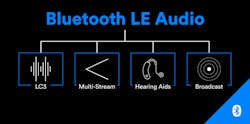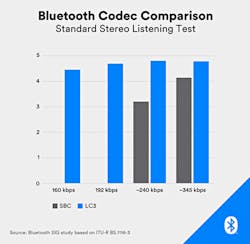What’s the Difference Between Bluetooth LE and Bluetooth LE Audio?
This is actually a story about the latest standard from the Bluetooth SIG, Bluetooth LE Audio. The new standard differs from Bluetooth Low Energy, which is abbreviated Bluetooth LE or even BLE. Bluetooth LE came out about a decade ago and the latest standard is Bluetooth 5.
The brand-new Bluetooth LE Audio was announced at the recent Consumer Electronics Show (CES). It represents a fundamental change to how Bluetooth handles audio, which is one of the primary uses for Bluetooth. The original Bluetooth audio support is now known as “Classic Audio,” while the new version is dubbed “LE Audio”.
LE Audio isn’t backwards-compatible with Classic Audio; therefore, you will need new devices to take advantage of the technology. New devices, like smartphones, that can support LE Audio will be able to support Classic Audio as well. On the other hand, it’s unlikely that current Classic Audio devices can be upgraded to handle LE Audio.
Some of the new enhancements in LE Audio (Fig. 1) include the Low Complexity Communications Codec (LC3), multidevice streaming support, support for hearing aids, and a broadcast feature that differs from the earlier beacon support.
The LC3 support is one of the main driving factors behind LE Audio. It improves audio quality while providing better listening support in low-bandwidth environments. Testing shows that the overall listening quality using LC3 is better than the existing Classic Audio codec—even at bandwidths below that supported by Classic Audio (Fig. 2).
According to Manfred Lutzky, Head of Audio for Communications at Fraunhofer IIS, “Extensive listening tests have shown that LC3 will provide improvements in audio quality over the SBC codec included with Classic Audio, even at a 50% lower bit rate. Developers will be able to leverage this power savings to create products that can provide longer battery life or, in cases where current battery life is enough, reduce the form factor by using a smaller battery.”
Multi-stream support in LE Audio enables a single source to send the same stream to multiple devices. Some systems supported this outside of the standard, and in applications like earbuds, one of earbuds normally received a stereo stream and sent one channel to the other earbud. Multi-stream allows the host device to send a stream to both earbuds, which can reduce power requirements and system complexity.
Hearing aids would seem an ideal application for Bluetooth; in fact, Bluetooth hearing aids already exist. The challenge is to provide better support, especially for developers.
Bluetooth beacon support enables broadcasting of non-audio content primarily for location-based advertising. LE Audio is designed to handle audio streaming and essentially allows a local source to stream audio to any number of devices, much like radio reception albeit with a more limited range. It could be used at concerts or games. Or it could be used to provide multiple translations of an event.
Bluetooth LE Audio devices aren’t available yet—the chipsets and development tools are only coming online now. The next CES, though, will likely be inundated with LE Audio devices.
About the Author
William G. Wong
Senior Content Director - Electronic Design and Microwaves & RF
I am Editor of Electronic Design focusing on embedded, software, and systems. As Senior Content Director, I also manage Microwaves & RF and I work with a great team of editors to provide engineers, programmers, developers and technical managers with interesting and useful articles and videos on a regular basis. Check out our free newsletters to see the latest content.
You can send press releases for new products for possible coverage on the website. I am also interested in receiving contributed articles for publishing on our website. Use our template and send to me along with a signed release form.
Check out my blog, AltEmbedded on Electronic Design, as well as his latest articles on this site that are listed below.
You can visit my social media via these links:
- AltEmbedded on Electronic Design
- Bill Wong on Facebook
- @AltEmbedded on Twitter
- Bill Wong on LinkedIn
I earned a Bachelor of Electrical Engineering at the Georgia Institute of Technology and a Masters in Computer Science from Rutgers University. I still do a bit of programming using everything from C and C++ to Rust and Ada/SPARK. I do a bit of PHP programming for Drupal websites. I have posted a few Drupal modules.
I still get a hand on software and electronic hardware. Some of this can be found on our Kit Close-Up video series. You can also see me on many of our TechXchange Talk videos. I am interested in a range of projects from robotics to artificial intelligence.



